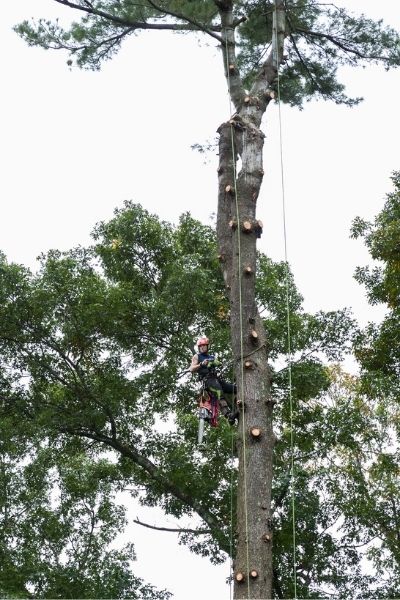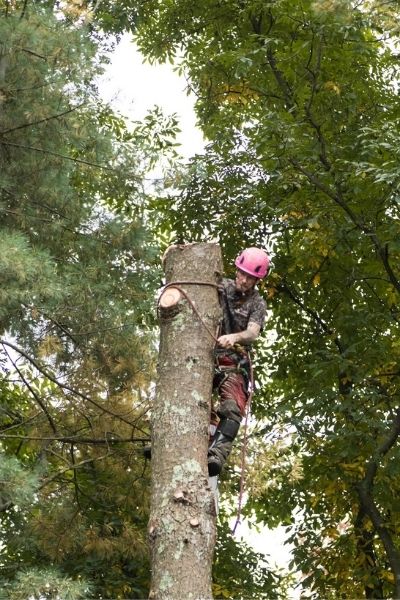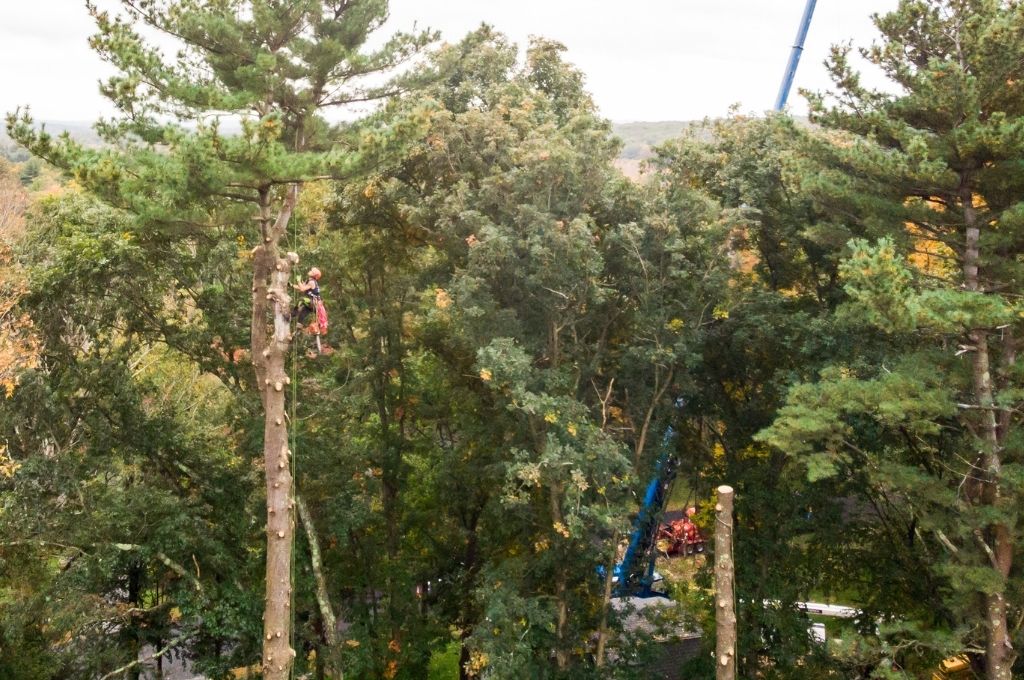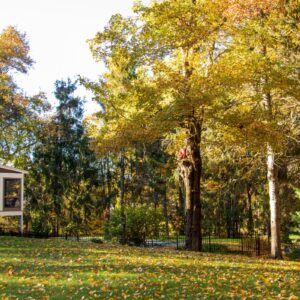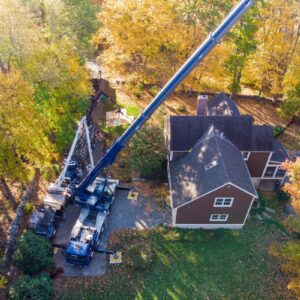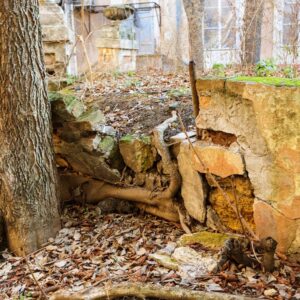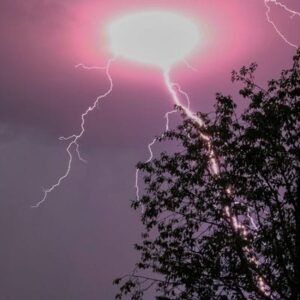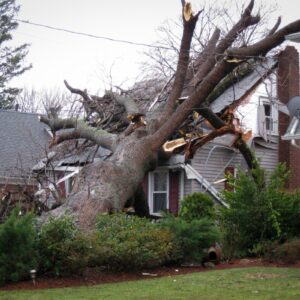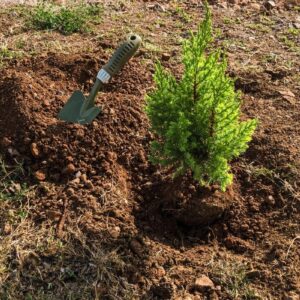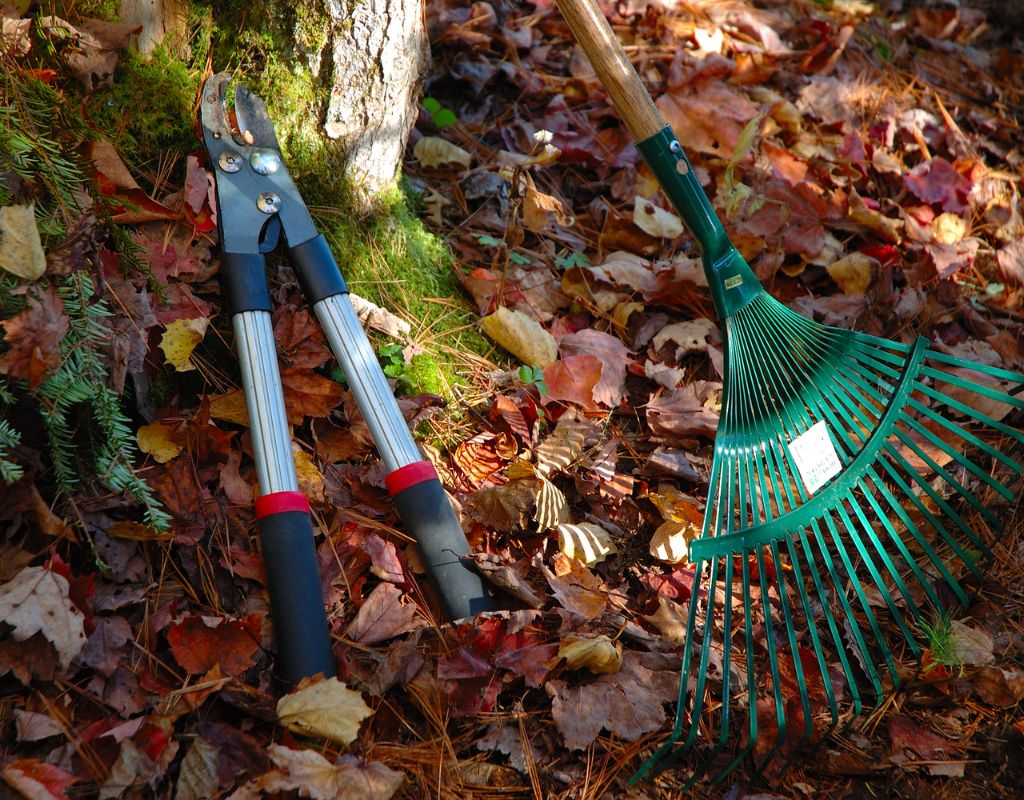Pine trees might look sturdy, but when it comes to removal, they can be some of the trickiest trees to deal with. Their towering height, brittle branches, and heavy, sap-covered limbs make the job anything but simple. In MetroWest, Massachusetts, where pines are common, taking one down safely requires the right equipment, experience, and a solid game plan. Here’s why pine tree removal isn’t something you want to tackle on your own.
Key Takeaways:
- Massachusetts pine trees, particularly eastern white pine, pitch pine, and red pine, can grow to extreme heights of 100-200 feet, making them impossible for homeowners to remove without professional help.
- Pines’ unique whorled branch structure creates a dense maze of branches, making climbing and removal significantly more challenging than deciduous trees.
- Pine sap can gum up equipment, stick to everything it touches, and render wood chippers inoperable.
- Pine branches are deceptively heavy due to moisture-filled needles, requiring special equipment and techniques for safe removal, especially in confined spaces common in MetroWest Massachusetts.
- The soft, brittle nature of pines makes climbing them particularly dangerous, as branches can snap unexpectedly.
3 Most Common Pines in Massachusetts
The three most common pines in the MetroWest area of Massachusetts are:
- Eastern White Pine (Pinus strobus L.): The tallest native conifer in the northeast, the eastern white pine typically grows up to 100 feet tall (up to 150 feet in optimal growing conditions) with a 2 to 4-foot diameter trunk.
- Pitch Pine (Pinus rigida): Although a smaller tree, the pitch pine still grows 50-80 feet tall with a 1 to 2-foot trunk.
- Red Pine (Pinus resinosa): Also known as Norway pine, this tree has a dense, oval crown and usually grows up to 75 to 80 feet (sometimes even 200 feet tall!). The trunk diameter is typically between 2 and 3 feet.
PRO TIP: Eastern white pines face numerous threats – like white pine needle disease, white pine bast scale, and caliciopsis canker – that have caused many of them to die in recent years. Be on the lookout for these threats, and consider keeping any eastern white pines on your property to preserve our ecosystem.
5 Aspects That Make Pine Tree Removal Difficult for Homeowners
There are a few inherent aspects of pines that make removing them more difficult than removing many deciduous trees. While a homeowner may be able to take care of a small ornamental tree on their own, pine tree removal is never a DIY job for five key reasons.
1. Pine Tree Height
Mature pine trees are very tall, making removal tricky. If you have enough space, it would be possible to cut the tree at the base to fell it, and then cut it into smaller pieces for disposal while on the ground. However, in areas like Framingham in the MetroWest area, there’s likely not enough room on your property to let a massive tree fall without causing damage or injuries.
A professional service must use advanced techniques and equipment to remove them efficiently and without putting your property at risk. Some of the equipment we’ll have to use to remove a pine includes:
- Rigging Equipment: Rigging equipment allows us to lower cut portions of the tree to the ground safely.
- Bucket Truck: A bucket truck allows our tree removal team to access the upper portion of a pine tree without climbing into the tree.
- Tree Removal Crane: Our team can lift cut portions of the tree over obstacles and houses with a tree removal crane.
2. Pine Tree Branch Structure
The way that pines grow is different from other types of trees, such as deciduous hardwoods. Young pines already have a strong central leader and develop neat ranks of horizontal branches. Each rank, or layer, of branches grows around the circumference of the pine’s trunk like a ring. We call this a “whorled” growth pattern and is one way we classify conifers.
There’s nothing inherently wrong with this branch structure, but it makes it much more difficult to climb a pine tree. Often, the climber has to work their way through a maze of branches and make many more pruning cuts compared to other trees.
3. Pine Sap
Cutting pines and their branches means we also see a lot of sap (also known as resin or gum). It is sticky, persistent, and tough to eliminate. While pine sap flow fluctuates by season, any tree wound (including good pruning cuts) creates a sap-flow response. During the growing season, the sap is plentiful and fast-flowing and slower and thicker during other periods of the year.
Sap complicates tree removal and affects various items, including:
- Saws and Blades: Sap can gum up cutting blades, rendering them less effective or useless. Cleaning the tools will cost time and money and slow the process.
- Surfaces Near the Tree: Sap can mix with sawdust and stick to nearby hardscapes or lawn decorations. It may also stick to our equipment and protective gear, necessitating cleanup to keep the project safe.
- Chippers: Excessive sap can slow down large chippers or render small chippers clogged and inoperable.
PRO TIP: Pine sap isn’t poisonous or dangerous. However, it gets everywhere, and it’s challenging to get off. You’ll need rubbing alcohol, nail polish remover, or vegetable oil to remove it, depending on the surface type.
4. Heavy Pine Branches
When removing a pine tree, the best way to minimize sticky sap is to make fewer thinning cuts and instead remove entire limbs at their attachment point on the trunk. This approach speeds up the process and reduces excessive sap exposure.
Once those large branches are on the ground, you’ll quickly discover how heavy they are. Pine needles are full of moisture and weigh more than you’d expect. We’ll have to drag the large branches by hand so we can cut them into small pieces and load them into the truck or chip them.
5. Soft, Brittle Wood of Evergreen Trees
Since we can’t always use a crane to remove a pine tree, our climbers often take on the job. Using climbing spikes attached to their boots, they can quickly scale the tree for removal.
Pine trees have softwood, which makes them easy to climb with spikes—but that also comes with risks. The same softwood that allows for easy ascent can tear easily, causing spikes to slip. Additionally, pine branches are brittle and can snap under a climber’s weight or break unpredictably when cut, creating a serious hazard.
Because of these challenges, climbing and removing pines is a delicate and dangerous process that requires experience and precision.
PRO TIP: Want to learn more about tree removal in the MetroWest area? Read any of our previous articles:
Frequently Asked Questions About Pine Tree Removal
Do you still have some questions about pine tree removal and why it can be difficult? We’ve compiled some common questions we get from MetroWest homeowners on the topic.
How can I tell if I need to remove my pines?
Some of the reasons we remove a pine tree include:
- The tree is too tall
- The canopy blocks sunlight to the areas below it
- The sap has become a nuisance
- The tree is dead or dying
- The pollen is intolerable
When is the best time to remove a pine?
Unlike some other trees, pines don’t go dormant in winter, so they can be removed any time of year. However, if the tree is damaged, diseased, or poses a risk to your property, it’s best to have a professional remove it as soon as possible.
What happens to the wood from cut pines?
Pines do not make desirable firewood. A tree service company will chip the smaller pieces of the cut tree on-site and transport the rest to a facility to be processed. If you would like to keep some wood, discuss it with the team before they remove the tree.
Can tree removal companies remove a pine that’s in a confined space?
Yes, a tree service can remove trees in confined spaces. They will typically use a combination of a tree removal crane and extensive rigging to complete the process without any harm.
Trust American Climbers for Safe Pine Tree Removal
Don’t risk a DIY pine tree removal. Our skilled team at American Climbers has the specialized equipment and expertise to safely remove any pine in the MetroWest area. Call 508-497-8628 or request a quote online today.
Blog Topics
Recent Posts
What's Happening? Stay Informed!
Stay on top of local events, pest and disease updates, tree and landscape tips, and more. Delivered straight to your inbox each month.

